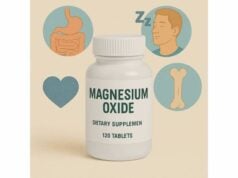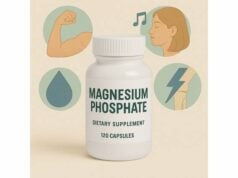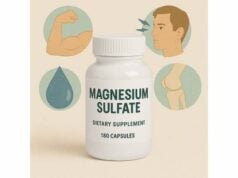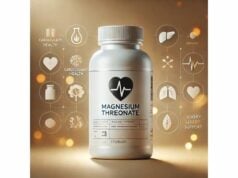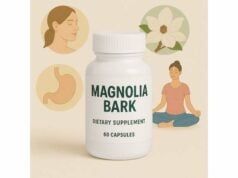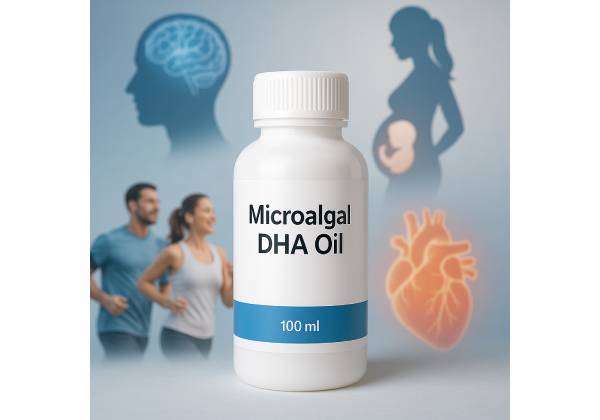
Microalgal DHA oil provides a direct, plant-based source of docosahexaenoic acid (DHA)—the long-chain omega-3 that accumulates in the brain, eyes, and heart membranes. Unlike alpha-linolenic acid (ALA) from flax or chia, DHA from microalgae is preformed and efficiently raises blood and red-cell DHA levels. Produced in closed, food-grade fermentation tanks (commonly from Schizochytrium species), algal oils avoid marine contaminants and offer a sustainable alternative to fish oil. People choose microalgal DHA to support pregnancy and breastfeeding, reduce omega-3 gaps in vegan or low-fish diets, and complement cardiovascular nutrition strategies. In capsules or liquid, most products deliver 200–400 mg DHA per serving; some combine small amounts of EPA as well. Used sensibly, algal DHA is well tolerated. However, high-dose omega-3s can interact with blood-thinning medicines, and dosing needs vary by life stage and health goals. This guide translates the science into practical steps—how it works, who benefits, how to choose a quality product, how much to take, and what to watch for—so you can make confident, evidence-aware decisions.
Key Insights
- Raises DHA status effectively in vegans, vegetarians, and low-fish eaters.
- Supports pregnancy needs; aim for at least 100–200 mg DHA/day, higher if status is low.
- Typical daily adult range: 200–500 mg DHA; start with meals to improve tolerance.
- Mild GI upset may occur; very high intakes can increase bruising risk, especially with anticoagulants.
- Avoid or get medical guidance if you have bleeding disorders, upcoming surgery, or take warfarin or dual antiplatelet therapy.
Table of Contents
- What is microalgal DHA oil?
- Does microalgal DHA work for heart and brain?
- Science-backed benefits and mechanisms
- How to choose, store, and use it
- How much DHA should I take daily?
- Side effects, interactions, and who should avoid
What is microalgal DHA oil?
Microalgal DHA oil is a purified lipid extract rich in docosahexaenoic acid (DHA), typically produced by fermenting marine microorganisms such as Schizochytrium or Crypthecodinium. These organisms naturally synthesize DHA; fish obtain DHA by eating microalgae and plankton, which is why algal oil is often described as “getting omega-3s from the original source.” Modern industrial fermentation occurs in closed stainless-steel bioreactors under controlled temperature, oxygen, and nutrient conditions. After cultivation, the biomass is separated and the oil is extracted, filtered, deodorized, and standardized to a specified DHA percentage (commonly 35–55% DHA by weight). Final oils may be in triglyceride form (the same form found in foods and most human tissues) or less commonly as ethyl esters; many vegan supplements use triglyceride or re-esterified triglyceride formats for stability and bioavailability.
DHA is a 22-carbon, six-double-bond fatty acid that integrates into phospholipids, especially in the brain, retina, and heart. There it influences membrane fluidity, receptor function, signal transduction, and the formation of specialized pro-resolving mediators (SPMs) involved in the resolution of inflammation. Because humans convert very little ALA (from flax, chia, walnuts) into DHA—typically less than a few percent—direct dietary DHA can be important when fish intake is low, during pregnancy and lactation, and for individuals with higher needs or genetic variants that reduce conversion.
Algal DHA is prized for three practical reasons. First, it is animal-free and thus suitable for vegetarians and vegans. Second, closed fermentation minimizes exposure to ocean-borne contaminants such as methylmercury and persistent organic pollutants; reputable manufacturers test every batch for oxidation and impurities. Third, algal production is scalable and less dependent on wild fisheries, improving sustainability metrics. These features explain why algal DHA appears in prenatal vitamins, infant formulas, medical foods, and many mainstream omega-3 products.
Flavor and tolerability have improved markedly over the last decade. Deodorization and antioxidant systems (mixed tocopherols, rosemary extract, ascorbyl palmitate) limit off-flavors and protect against rancidity. Softgels, small capsules, and emulsified liquids help users meet target intakes without fishy repeat. Still, as with any oil, improper storage or long shelf time can increase peroxide (primary oxidation) and anisidine (secondary oxidation) values; quality-focused brands publish third-party certificates of analysis (COAs).
In short, microalgal DHA oil delivers the same physiologically active DHA found in fish, in a vegan, contaminant-controlled, and sustainability-forward format that reliably raises blood and tissue DHA when taken consistently.
Does microalgal DHA work for heart and brain?
Yes—when the goal is to raise DHA status and support tissues that depend on DHA, microalgal DHA works. Multiple human studies demonstrate that algal DHA increases DHA in plasma and red blood cells, often to a similar extent as fish-derived DHA when doses match. That is the key point: the body recognizes DHA by its molecular structure, not its source. Practical outcomes depend on two variables—dose and baseline status. People with low omega-3 intake (vegans, vegetarians, or those who rarely eat fish) typically show the largest increases after supplementation. In head-to-head comparisons of equivalent DHA doses, algal DHA and fish sources have produced comparable rises in DHA biomarkers over several weeks, indicating bioequivalence in terms of delivery to the bloodstream and cells.
For cardiovascular support, long-chain omega-3s influence triglycerides, lipoprotein particle characteristics, endothelial function, heart rate variability, and the resolution of inflammation. Evidence that specifically isolates DHA alone for hard cardiovascular outcomes is mixed; large prescription trials often used combined EPA+DHA or prescription EPA alone at grams-per-day doses for hypertriglyceridemia or event-risk modulation. Nonetheless, modest, food-level intakes of long-chain omega-3s, including DHA, are a cornerstone of many dietary guidelines for heart health. At typical supplement doses (200–500 mg/day DHA), benefits are most plausibly seen as gradual improvements in omega-3 status and supportive effects on lipid biology rather than as stand-alone drug-like impacts.
For the brain and eyes, DHA is structurally integral. The retina concentrates DHA in photoreceptor outer segments, and the brain incorporates DHA into synaptic membranes. Observational data link higher DHA status to markers of healthy cognitive and retinal function across the lifespan, though randomized trials show heterogeneous results depending on population, baseline status, and endpoints measured. Two areas where DHA sufficiency is particularly emphasized are pregnancy and early life: DHA supports fetal and infant brain and visual development. Professional guidelines commonly recommend that women of childbearing age meet baseline omega-3 needs and that during pregnancy, additional DHA intake be prioritized—especially in individuals with low dietary omega-3 intake or low blood DHA levels.
It is also worth noting what algal DHA is not. It is not a panacea, and it cannot replace comprehensive cardiovascular or neurological care. Its effects are nutritional and cumulative; consistency matters more than sporadic high doses. Benefits are most likely when algal DHA plugs a real gap—low omega-3 intake, elevated triglycerides as part of a broader lifestyle plan, or the heightened demands of pregnancy—rather than when added to an already sufficient omega-3 pattern.
Bottom line: microalgal DHA is an effective, vegan way to raise DHA status that supports heart, brain, and visual physiology, with the strongest practical rationale in populations with low baseline omega-3 intake and during pregnancy.
Science-backed benefits and mechanisms
Raises DHA status reliably. Controlled studies consistently show that microalgal DHA increases DHA in blood fractions (plasma phospholipids and erythrocytes) within weeks. In trials using matched doses, algal DHA elevates biomarkers to a similar magnitude as fish-derived DHA, supporting true bioequivalence for status improvement. This matters because the red-blood-cell “omega-3 index” (EPA+DHA as a percent of RBC fatty acids) correlates with long-term intake and tissue enrichment.
Pregnancy and early life support. DHA accrues rapidly in the fetal brain and retina, especially in the third trimester. Professional consensus documents emphasize ensuring at least baseline omega-3 supply in women of childbearing age and adding DHA during pregnancy. Where maternal intake or status is low, intakes around several hundred milligrams per day of DHA (with or without EPA) beginning before mid-pregnancy have been associated with a reduced risk of early preterm birth in some analyses. Not every study agrees, and effects vary by baseline status, dose, and timing. However, the consistent thread is that the mothers who benefit most are those starting with lower omega-3 intakes or lower blood DHA. Algal DHA, being fish-free and tightly quality-controlled, is a practical way to meet these targets for people who avoid or limit seafood.
Lipid metabolism and triglycerides. Long-chain omega-3s reduce hepatic VLDL-triglyceride synthesis and increase beta-oxidation, lowering fasting triglycerides in a dose-responsive fashion at higher intakes. DHA alone, at gram-level intakes, can modestly affect LDL-cholesterol in some people (often a small rise in LDL-C that may reflect larger, less atherogenic particles), while lowering triglycerides. At commonly used nutritional doses (200–500 mg DHA/day), the principal effect is status improvement, with triglyceride effects more evident at higher intakes and in individuals with elevated baseline triglycerides.
Cell membranes and inflammation resolution. DHA integrates into membrane phospholipids, increasing fluidity and affecting the function of embedded proteins such as ion channels and receptors. Enzymatic conversion of DHA yields docosanoids, including D-series resolvins and protectins, which support the active resolution phase of inflammation—shifting biology away from chronic, low-grade inflammatory tone. This “resolution” concept is distinct from broad immunosuppression; it facilitates a return to homeostasis after inflammatory triggers. In the retina, DHA’s biophysical properties support photoreceptor disc renewal and visual transduction; in the brain, membrane DHA affects synaptogenesis, neurotrophic signaling, and neurotransmission.
Sustainability and purity advantages. Modern algal DHA production reduces strain on wild fisheries and offers predictable composition. Closed fermentation minimizes exposure to environmental contaminants, and rigorous refining removes impurities. For consumers, this typically translates to lower heavy-metal concern, though oxidation stability still matters. Choosing brands that provide batch-specific oxidation values (peroxide and anisidine) and third-party testing strengthens quality assurance.
Who benefits most.
- Vegans and vegetarians: Algal DHA reliably increases DHA and the omega-3 index where ALA conversion alone is insufficient.
- Pregnant or breastfeeding individuals: Meeting DHA needs supports fetal and infant development; algal DHA is a fish-free option.
- People with low fish intake: One to two algal DHA capsules can approximate the DHA in a serving of fatty fish.
- Those focusing on triglycerides: Meaningful triglyceride reductions generally require higher total long-chain omega-3 intakes (often ≥1–2 g/day DHA+EPA), best individualized with clinician input.
Overall, microalgal DHA oil delivers the biological actions of DHA—membrane integration, signaling, and inflammation resolution—with practical strengths in status improvement, pregnancy support, and sustainable sourcing.
How to choose, store, and use it
1) Read the label for real DHA per serving. Many bottles highlight “omega-3” or “algal oil” milligrams; what matters is the DHA content in mg per capsule or teaspoon. Typical capsules provide 200–400 mg DHA; liquids vary. If you are targeting 300 mg/day and your capsule contains 250 mg DHA, one capsule daily most days will meet the mark; adjust based on diet.
2) Prefer products with transparent testing. Quality brands post a batch certificate of analysis (COA) showing:
- Peroxide value (PV) and anisidine value (AV) within tight limits (lower is better).
- DHA content meeting the label claim throughout shelf life.
- Purity tests for heavy metals, solvents, and microbial contamination.
Third-party seals (e.g., IFOS, USP) signal extra oversight, but batch-level data are most telling.
3) Choose the right form and capsule. Most algal DHA is in triglyceride form, which is well absorbed and gentle on the stomach when taken with food. If you struggle with swallowing pills, look for mini-softgels, chewables, or flavored liquids. Some vegan capsules use carrageenan; if you’re sensitive, opt for alternative capsules (e.g., modified cornstarch, pullulan) or liquids.
4) Pair with meals for comfort and absorption. Taking algal DHA with a meal that contains fat improves bioavailability and reduces burping. If you experience reflux, split the dose (e.g., 200 mg with breakfast and 200 mg with dinner) or switch to an emulsified liquid.
5) Store like a fresh oil. Keep bottles cool, dry, and away from light. Reseal tightly; refrigerate liquids after opening. Note the “opened” date; aim to use liquids within 60–90 days or as directed. Discard if you detect a sharp, paint-like odor—an oxidation sign.
6) Align product choice with your goals.
- Pregnancy: a prenatal or stand-alone DHA delivering 200–300 mg DHA/day (or more under clinician guidance if status is low).
- Vegan/low-fish diets: 200–400 mg DHA/day to raise and maintain omega-3 status.
- Triglyceride focus (with medical guidance): higher combined long-chain omega-3 intakes are often needed; some clinicians prefer combined DHA+EPA or prescription products.
- Child/family nutrition: consult pediatric guidance for age-appropriate doses; many children’s products provide 50–150 mg DHA per serving.
7) Check the fine print. Avoid formulas with flavorings you dislike, allergens (e.g., soy-derived carriers), or unnecessary additives. Ensure “vegan” claims are substantiated (no fish gelatin, no animal-derived vitamin carriers). If you take multiple supplements, watch for duplicate DHA in your prenatal, multivitamin, and stand-alone omega-3.
8) Think long term. Omega-3 benefits accrue with consistency. Set reminders, pre-place capsules with your coffee or toothbrush, or tie dosing to existing habits. If you miss a day, resume your normal schedule—no need to “double up.”
By focusing on labeled DHA content, independent testing, sensible storage, and steady intake, you can maximize the value of microalgal DHA with minimal hassle.
How much DHA should I take daily?
Dosing depends on age, diet, life stage, and goals. Use the ranges below as practical starting points, then personalize with your clinician if you have medical conditions, take medications, or are pregnant.
General healthy adults (low fish intake). A common, food-level target is 250–500 mg/day of combined long-chain omega-3s. If you’re using DHA-only algal oil, practical daily intakes of 200–400 mg DHA help raise and maintain DHA status. People with very low baseline omega-3 intake (e.g., long-term vegans) may benefit from the upper end initially, then re-evaluate after 8–12 weeks.
Pregnancy and preconception. Women of childbearing age should meet baseline omega-3 needs and add at least 100–200 mg/day of DHA in pregnancy. If dietary intake is low or blood DHA is low, clinical guidance often supports approximately 600–1000 mg/day of DHA+EPA—or DHA alone—starting before 20 weeks, continuing through late pregnancy. Many prenatal vitamins include 200–300 mg DHA; topping up with an additional algal DHA capsule is common when diet is low in seafood.
Lactation. Breast milk DHA reflects maternal intake. Continuing 200–400 mg/day DHA is a practical range to support milk DHA and maternal stores, especially if fish intake remains low.
Triglyceride management (medical supervision). Meaningful triglyceride reductions typically occur at ≥1–2 g/day of combined EPA+DHA, with higher prescription-level doses used for hypertriglyceridemia. If using DHA-only algal oil for this purpose, coordinate with your clinician; expect that higher doses and/or combined EPA+DHA strategies are often employed, and medication interactions must be reviewed.
Children and teens. Needs scale with age, diet, and clinical context. Many children’s products provide 50–150 mg DHA; pediatric recommendations vary. Discuss specific targets with your pediatrician, particularly for children with restricted diets or special needs.
Titration and timing.
- Start with food to improve comfort.
- Re-check status after 8–12 weeks if you have access to an omega-3 index or if you’re adjusting pregnancy dosing under medical guidance.
- Do not megadose without professional oversight; more isn’t automatically better, and very high intakes can interact with medications.
What if I eat fish? If you regularly consume 2–3 servings/week of oily fish (e.g., salmon, sardines, mackerel), you may already meet or exceed 250–500 mg/day long-chain omega-3 equivalents, and a small maintenance algal DHA dose—or none—might be sufficient. If you avoid fish or prefer vegan options, algal DHA at 200–400 mg/day is a straightforward replacement.
As always, align dosing with your goals: status maintenance, pregnancy support, or triglyceride focus. When in doubt, aim for consistency at a moderate dose and adjust with professional input and, when available, objective status measures.
Side effects, interactions, and who should avoid
Common, usually mild effects. Most people tolerate algal DHA well. The most frequent complaints are mild gastrointestinal symptoms—burping, a transient aftertaste, soft stools, or reflux—especially when capsules are taken on an empty stomach. Taking DHA with meals, splitting doses, or switching to an emulsified liquid usually resolves these issues.
Bleeding and bruising risk at high intakes. Long-chain omega-3s have antiplatelet effects. At typical nutritional intakes (≈200–500 mg/day DHA), clinically significant bleeding is uncommon. However, very high intakes (multi-gram/day combined omega-3) can increase bruising and may potentiate the effects of anticoagulants or antiplatelet drugs. Anyone on warfarin, DOACs, or dual antiplatelet therapy should consult their clinician before adding or escalating omega-3 supplements.
Lipid changes. In some individuals, higher-dose DHA can raise LDL-cholesterol modestly while lowering triglycerides. The LDL change often reflects a shift toward larger, less dense particles, but the net clinical significance depends on the whole lipid profile and risk context. If you track your lipids, re-check after several months on a new regimen.
Allergy and intolerance. Algal DHA itself is not a fish allergen, but check capsule ingredients. Some products use soy-derived carriers or specific gelling agents (e.g., carrageenan). If you have known sensitivities, choose formulations that disclose excipient sources clearly.
Glucose control and immune function. At moderate intakes, long-chain omega-3s do not generally impair glucose control or immune function in healthy adults. As with all supplements, balance and context matter—avoid displacing nutrient-dense foods with oils.
Who should get medical guidance first.
- People on blood thinners (warfarin, DOACs) or dual antiplatelet therapy.
- Individuals with bleeding disorders or upcoming surgery (typically pause high-dose omega-3s 1–2 weeks prior if your surgical team advises).
- Pregnant individuals considering more than standard prenatal DHA doses, especially if starting late in pregnancy or with medical complications.
- People with very high triglycerides or complex lipid disorders—coordinate with a clinician; prescription therapy may be indicated.
Practical safety tips.
- Choose products with freshness metrics (PV/AV) and certifications.
- Store properly to limit oxidation; do not use oils past their prime.
- Start low, go steady, and adjust based on tolerance and goals.
- Remember that DHA is a nutrient, not a cure; use it within an overall healthy diet and care plan.
Used thoughtfully and in the right context, microalgal DHA is a safe, effective way to meet DHA needs—particularly for vegan eaters and during pregnancy—while keeping risks low and manageable.
References
- Scientific Opinion on the Tolerable Upper Intake Level of eicosapentaenoic acid (EPA), docosahexaenoic acid (DHA) and docosapentaenoic acid (DPA) 2012 (Guideline)
- Omega-3 fatty acid supply in pregnancy for risk reduction of preterm and early preterm birth 2024 (Guideline)
- ISSFAL statement number 7 – Omega-3 fatty acids during pregnancy to reduce preterm birth 2022 (Guideline)
- Bioavailability and conversion of plant based sources of omega-3 fatty acids – a scoping review to update supplementation options for vegetarians and vegans 2022 (Systematic Review)
- Algal-oil capsules and cooked salmon: nutritionally equivalent sources of docosahexaenoic acid 2008 (RCT)
Disclaimer
This article is for educational purposes only and does not replace personalized medical advice, diagnosis, or treatment. Always consult a qualified healthcare professional before starting, changing, or stopping any supplement, especially if you are pregnant or breastfeeding, have a medical condition, or take prescription medications (including anticoagulants and antiplatelet agents).
If you found this guide helpful, please consider sharing it on Facebook, X (formerly Twitter), or your favorite platform, and follow us on social media. Your support helps us continue to create clear, evidence-informed resources.

